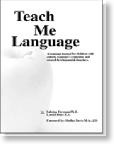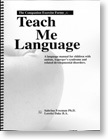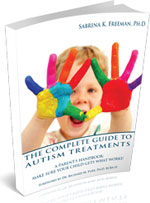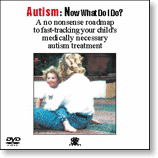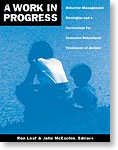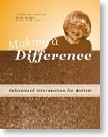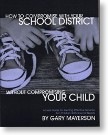inclusion
Are there any Summer camps that do disability inclusion right?
08/07/13 12:09 Filed in: autism
As Summer is upon us, the thought goes to Summer camp where many typically developing children spend a few weeks away from home, hopefully to have transformational camp experiences. Of course, we would love this for our children with autism as well, but then starts the depressing search, where we find no shortage of camps that segregate our children and frequently lump all children with disabilities into one heterogeneous group. The search for a Summer camp that is truly inclusive can be a difficult one.
I recently landed upon a website of a camp called Ramah that I think is actually doing inclusion right. Based on the six-minute description offered by the director of their special needs programs, it has been a process from segregation to integration based on parent request. In short, this is a Summer camp that actually listened to parents in their community!
The camp describes a four track orientation, with segregated cabins for some campers and vocational training during camp; however, they also offer an integrated cabin experience where they train staff prior to camp, and add an extra counsellor so that there is sufficient staff to ensure that the child with special needs is properly supported.
What impressed me most is that some of these campers with special needs actually went on to be hired by camp and became staff members themselves. That’s truly putting your money where your mouth is! Let’s hope that other camps emulate this model and truly integrate children with special needs into their communities.
I recently landed upon a website of a camp called Ramah that I think is actually doing inclusion right. Based on the six-minute description offered by the director of their special needs programs, it has been a process from segregation to integration based on parent request. In short, this is a Summer camp that actually listened to parents in their community!
The camp describes a four track orientation, with segregated cabins for some campers and vocational training during camp; however, they also offer an integrated cabin experience where they train staff prior to camp, and add an extra counsellor so that there is sufficient staff to ensure that the child with special needs is properly supported.
What impressed me most is that some of these campers with special needs actually went on to be hired by camp and became staff members themselves. That’s truly putting your money where your mouth is! Let’s hope that other camps emulate this model and truly integrate children with special needs into their communities.
Religiosity and Autism: Studying the Wrong Question
27/11/12 18:49 Filed in: autism | Asperger's Syndrome
A review of Why Religion is Natural and Science Is Not published in Psychology Today reported a lack of ability of those with autism to believe in God. Researchers have suspected:
“that religious belief and understanding is obstructed by ASD and that this results from impaired theory of mind capacities.”
New studies confirm this finding. My instant reaction was big surprise, and tell me something I don’t know! It’s not a big surprise that abstract thinking is typically difficult for people with autism. It may be hard to believe for some, but belief in God is not a prerequisite to be part of a faith-based community.
The article seems to make a connection between belief in a higher being and participation in religious life. Once again, these researchers are asking the wrong question.
Here’s why.
It is irrelevant to most families of children with autism whether their child with autism is a believer or not insofar as theory of mind issues make it a near impossibility. What is important, however, is that the faith-based community with which they are affiliated wholeheartedly embraces their child as a member! I suggest that the question that needs to be studied is which faith-based communities are most likely to integrate people with special needs into the broader community, irrespective of their ability to believe in a higher being. The biggest problem that families of children with autism face is not whether their children have faith, but rather, whether the community will accept their family now that they have a child afflicted with autism. Moreover, although children with autism may be tolerated, how will faith-based communities deal with these children when they reach adulthood? It’s one thing to integrate disabled children; it is quite another matter to embrace adults with autism in a faith-based community without the knee-jerk instinct to segregate.
The correct question to study is whether typically developing adults have the capacity in a faith-based organization to embrace people with special needs rather than just give lip service to it.
“that religious belief and understanding is obstructed by ASD and that this results from impaired theory of mind capacities.”
New studies confirm this finding. My instant reaction was big surprise, and tell me something I don’t know! It’s not a big surprise that abstract thinking is typically difficult for people with autism. It may be hard to believe for some, but belief in God is not a prerequisite to be part of a faith-based community.
The article seems to make a connection between belief in a higher being and participation in religious life. Once again, these researchers are asking the wrong question.
Here’s why.
It is irrelevant to most families of children with autism whether their child with autism is a believer or not insofar as theory of mind issues make it a near impossibility. What is important, however, is that the faith-based community with which they are affiliated wholeheartedly embraces their child as a member! I suggest that the question that needs to be studied is which faith-based communities are most likely to integrate people with special needs into the broader community, irrespective of their ability to believe in a higher being. The biggest problem that families of children with autism face is not whether their children have faith, but rather, whether the community will accept their family now that they have a child afflicted with autism. Moreover, although children with autism may be tolerated, how will faith-based communities deal with these children when they reach adulthood? It’s one thing to integrate disabled children; it is quite another matter to embrace adults with autism in a faith-based community without the knee-jerk instinct to segregate.
The correct question to study is whether typically developing adults have the capacity in a faith-based organization to embrace people with special needs rather than just give lip service to it.
Successful Autism Integration: How it makes ALL kids better human beings
02/05/12 13:08 Filed in: autism | Asperger's Syndrome
As parents of children with autism, we want our children to have the same kind of enriching experiences in life as do typically developing children. The best way to ensure a rich childhood, full of opportunities, is to integrate our children with typically developing children.
Unfortunately, there are often barriers created by a variety of people, particularly a small percentage of parents of typically developing children. These parents see no benefit for their children to be integrated with children who are challenged with special needs. This is particularly true when it comes to the integration of children afflicted with autism. Let’s face it: our children are not always reinforcing for others and they often behave in ways that completely ignore social norms. This can create discomfort for some.
However, what many parents of typically developing children do not understand is the tremendous value of successful integration of the disabled for their typically developing children.
So what is the value of successful integration for typically developing kids? Here is a partial list.
Typically developing children:
That’s a long list of very valuable benefits to integration; however, the most important benefit for typically developing children when they are properly integrated and interacting with children who suffer from autism, is that they learn to become decent human beings. I think most would agree we can use more of that in our society.
Many parents send their children to faith-based organizations to learn how to be a person with good values. Just add a child with autism to the mix, and the learning process is greatly accelerated.
Unfortunately, there are often barriers created by a variety of people, particularly a small percentage of parents of typically developing children. These parents see no benefit for their children to be integrated with children who are challenged with special needs. This is particularly true when it comes to the integration of children afflicted with autism. Let’s face it: our children are not always reinforcing for others and they often behave in ways that completely ignore social norms. This can create discomfort for some.
However, what many parents of typically developing children do not understand is the tremendous value of successful integration of the disabled for their typically developing children.
So what is the value of successful integration for typically developing kids? Here is a partial list.
Typically developing children:
- learn not to prejudge the ability of others
- learn how to break down skills and teach them to others, thereby becoming excellent teachers
- are exposed to exceptionally positive role models in the form of therapists, psychologists and tutors
- receive much more positive adult attention than they otherwise would in a large group of children, since successful integration requires the adult/child ratio to be greater
- learn to feel very good about themselves and their ability to lead
- are forced to look beyond their egocentric world and see that there are others in the world with real challenges, who are far less fortunate only because they drew the short straw in life’s lottery
- become very comfortable with people who are disabled
- learn empathy
- are protected from bullying due to the increased adult supervision that surrounds children with autism
- are provided more enriching opportunities due to the adults who often orchestrate and/or design rich social interactions
- are exposed to potential career opportunities and lucrative job prospects
- have a great experience to put on their resume when applying to college
That’s a long list of very valuable benefits to integration; however, the most important benefit for typically developing children when they are properly integrated and interacting with children who suffer from autism, is that they learn to become decent human beings. I think most would agree we can use more of that in our society.
Many parents send their children to faith-based organizations to learn how to be a person with good values. Just add a child with autism to the mix, and the learning process is greatly accelerated.
Autism Integration Mustn't Be a Boilerplate Approach
24/04/12 12:21 Filed in: autism
Educational and recreational segregation used to be the model for children with special needs. Then, integration came into vogue. Now we’re got segregationists debating integrationists, and truly, we’re all missing the point.
Recently I heard an interview given by a blogger, Harold Dougherty who describes his child being forced into an integrated setting that was a disaster for his son. He describes the new bureaucrat in charge as being an integration extremist, with very bad consequences for the child. This situation is outrageous!
The issue is not segregation versus integration, but rather that children should never be FORCED to be either integrated or segregated. Instead of being placed in a setting that works best for the child in consultation with the child’s treatment team, some children are apparently placed based on a) the philosophy of the reigning bureaucrat or “educrat” of the day and/or b) the cheapest placement for the school district.
Every child should have the right to be integrated when the integration works FOR THAT CHILD. When an integrated setting is inappropriate and does not work, the answer is not a segregated setting with a group of children who are being ghettoized but rather, one-on-one treatment that is customized for the specific child with autism. Then, the treatment professional can grab every possible integration opportunity available for that child when it works, and can work toward integration opportunities when the child needs to learn pro-social behaviors and routines prior to the effort at integration.
To illustrate, it may be counterproductive for an untreated child suffering from severe autism to be placed in a calculus class. Prior to placing the child in the integrated setting, he or she needs to learn the skills and routines to be successful in that setting. This goes for educational settings as well as recreational settings.
Put simply, the autism treatment team, along with the parent, should be making all integration decisions for the child rather than the school district!
For any education bureaucrats out there, remember, Individual Education Plans (IEPs) are called “individual” for a reason!
Recently I heard an interview given by a blogger, Harold Dougherty who describes his child being forced into an integrated setting that was a disaster for his son. He describes the new bureaucrat in charge as being an integration extremist, with very bad consequences for the child. This situation is outrageous!
The issue is not segregation versus integration, but rather that children should never be FORCED to be either integrated or segregated. Instead of being placed in a setting that works best for the child in consultation with the child’s treatment team, some children are apparently placed based on a) the philosophy of the reigning bureaucrat or “educrat” of the day and/or b) the cheapest placement for the school district.
Every child should have the right to be integrated when the integration works FOR THAT CHILD. When an integrated setting is inappropriate and does not work, the answer is not a segregated setting with a group of children who are being ghettoized but rather, one-on-one treatment that is customized for the specific child with autism. Then, the treatment professional can grab every possible integration opportunity available for that child when it works, and can work toward integration opportunities when the child needs to learn pro-social behaviors and routines prior to the effort at integration.
To illustrate, it may be counterproductive for an untreated child suffering from severe autism to be placed in a calculus class. Prior to placing the child in the integrated setting, he or she needs to learn the skills and routines to be successful in that setting. This goes for educational settings as well as recreational settings.
Put simply, the autism treatment team, along with the parent, should be making all integration decisions for the child rather than the school district!
For any education bureaucrats out there, remember, Individual Education Plans (IEPs) are called “individual” for a reason!
How To Skate Around Discrimination
21/02/12 11:09 Filed in: autism | Asperger's Syndrome
I just read about the latest battles of a family that successfully integrated a child into skating lessons. This story transported me back in time to when I had to convince various teachers that having a child with a “helper” is the best way to successfully integrate my child into an activity.
I can’t believe that I’m still reading about the same issue twenty years later! In this article, the parents were savvy. They quickly went over the head of the luddite who has no concept of the term “accommodation” and called the media. In this case, the media did their job and put pressure on the mayor, who immediately realized that this flawed policy must be changed. Kudos to those smart parents who leveraged the media to change a policy that is going to help every child with special needs who follows. I’ve written in the past on how to address this problem in a non-confrontational manner; however, since this pattern keeps rhyming, it is worth revisiting the issue.
Based on the lessons learned from this news story, here are the following steps you may consider taking when you sniff a potential problem when integrating your child: first, approach the person in charge of registration and with a very energetic, positive demeanor say that you’d love to have your child learn how to skate (swim, dance or whatever); however, due to your child’s special needs, you have a shadow aide, or helper, to provide free of charge to the class to support your child. You may want to add that this person knows your child quite well and will only jump in when your child has a problem understanding the directions given by the instructor.
One of two things will happen: the manager will say yes, or no.
If you are given permission, congratulations! If the manager is amenable (and you feel comfortable), then you may add that it would be less stigmatizing for the child if the helper could wear a T-shirt with the name of the rink on it, and thereby keep the children and parents guessing regarding who this second adult is in class. Your child’s shadow will simply look like a regular volunteer, not necessarily there for your child.
If the manager declines, then it is time for step two: phone your local paper and set up an interview about how the publicly funded recreation center is discriminating against a disabled child. If the reporter is not seasoned enough to interview the mayor, you might want to suggest it. In addition, if you are lucky enough to live in a country with laws protecting your child, you may want to mention those laws to the reporter. If you want to make the rubble bounce, it may be useful to send the reporter a link to the website with those laws, and copy and paste the specific part of the law into the body of the e-mail. If you are not lucky enough to have those laws at your fingertips, another idea is to contact all the various disability groups and mention that it may be a good idea for them to contact the reporter and their politicians. The pressure put on these folks will generally be too much to handle and accommodations will be made.
Ironically, once you succeed in integrating your child and they realize that life as we know it did not end, the recreation center will celebrate its success in being so open-minded and progressive! Let them own your victory; that will help the next child in line, and that child’s parent who will have no clue that the reason it was so easy to include a shadow teacher is because of a bloody minded parent who preceded them.
Here’s to bloody-minded parents!
I can’t believe that I’m still reading about the same issue twenty years later! In this article, the parents were savvy. They quickly went over the head of the luddite who has no concept of the term “accommodation” and called the media. In this case, the media did their job and put pressure on the mayor, who immediately realized that this flawed policy must be changed. Kudos to those smart parents who leveraged the media to change a policy that is going to help every child with special needs who follows. I’ve written in the past on how to address this problem in a non-confrontational manner; however, since this pattern keeps rhyming, it is worth revisiting the issue.
Based on the lessons learned from this news story, here are the following steps you may consider taking when you sniff a potential problem when integrating your child: first, approach the person in charge of registration and with a very energetic, positive demeanor say that you’d love to have your child learn how to skate (swim, dance or whatever); however, due to your child’s special needs, you have a shadow aide, or helper, to provide free of charge to the class to support your child. You may want to add that this person knows your child quite well and will only jump in when your child has a problem understanding the directions given by the instructor.
One of two things will happen: the manager will say yes, or no.
If you are given permission, congratulations! If the manager is amenable (and you feel comfortable), then you may add that it would be less stigmatizing for the child if the helper could wear a T-shirt with the name of the rink on it, and thereby keep the children and parents guessing regarding who this second adult is in class. Your child’s shadow will simply look like a regular volunteer, not necessarily there for your child.
If the manager declines, then it is time for step two: phone your local paper and set up an interview about how the publicly funded recreation center is discriminating against a disabled child. If the reporter is not seasoned enough to interview the mayor, you might want to suggest it. In addition, if you are lucky enough to live in a country with laws protecting your child, you may want to mention those laws to the reporter. If you want to make the rubble bounce, it may be useful to send the reporter a link to the website with those laws, and copy and paste the specific part of the law into the body of the e-mail. If you are not lucky enough to have those laws at your fingertips, another idea is to contact all the various disability groups and mention that it may be a good idea for them to contact the reporter and their politicians. The pressure put on these folks will generally be too much to handle and accommodations will be made.
Ironically, once you succeed in integrating your child and they realize that life as we know it did not end, the recreation center will celebrate its success in being so open-minded and progressive! Let them own your victory; that will help the next child in line, and that child’s parent who will have no clue that the reason it was so easy to include a shadow teacher is because of a bloody minded parent who preceded them.
Here’s to bloody-minded parents!
Finding Religion to End Run Autism Education Discrimination
10/02/12 17:32 Filed in: autism | Asperger's Syndrome
Isn’t it grand when the public school system successfully mainstreams children with autism. When everyone works together and makes the child with autism a valued member of the classroom, it’s truly wonderful!
What happens, though, when this is not the reality? Parents have three choices: 1) they can accept the sub-standard educational experience offered to their child and live with this depressing reality for 13 years, 2) they can fight the system, getting the lawyers to communicate in a way that makes the school do the right thing (often mortgaging their house to pay for the fight), or 3) they can place their child in private school.
Here’s where religion comes in. When shopping for a private school, it may be wise to “find religion” because your odds of finding a private school that will actually take your child increases once you add parochial schools to the mix! In addition, many religious private schools are not as expensive since they are often subsidized by members of the associated congregation. An additional benefit is that your child becomes a member of a peer group that is being taught kindness and inclusion for special needs children as part of religious teachings.
Not all religious school administrators are equally open-minded; however, you can visit a number of parochial schools until you meet a religious leader who is sufficiently pious to do the right thing. The advantage of a private school is that you are the customer and, therefore, the school has more incentive and flexibility to meet the needs of your child.
Sometimes it’s worth fighting the powers that be to make sure your child has access to the neighborhood school and, therefore, the neighborhood kids; however, sometimes the battle may be too painful, onerous or impossible to win. When the battle against intransigent public schools hits the wall, it may be time to find a welcoming religious community to provide your child with a viable alternative.
What happens, though, when this is not the reality? Parents have three choices: 1) they can accept the sub-standard educational experience offered to their child and live with this depressing reality for 13 years, 2) they can fight the system, getting the lawyers to communicate in a way that makes the school do the right thing (often mortgaging their house to pay for the fight), or 3) they can place their child in private school.
Here’s where religion comes in. When shopping for a private school, it may be wise to “find religion” because your odds of finding a private school that will actually take your child increases once you add parochial schools to the mix! In addition, many religious private schools are not as expensive since they are often subsidized by members of the associated congregation. An additional benefit is that your child becomes a member of a peer group that is being taught kindness and inclusion for special needs children as part of religious teachings.
Not all religious school administrators are equally open-minded; however, you can visit a number of parochial schools until you meet a religious leader who is sufficiently pious to do the right thing. The advantage of a private school is that you are the customer and, therefore, the school has more incentive and flexibility to meet the needs of your child.
Sometimes it’s worth fighting the powers that be to make sure your child has access to the neighborhood school and, therefore, the neighborhood kids; however, sometimes the battle may be too painful, onerous or impossible to win. When the battle against intransigent public schools hits the wall, it may be time to find a welcoming religious community to provide your child with a viable alternative.
I sure hope autism centers aren't stealth segregation
12/01/12 12:53 Filed in: autism | Asperger's Syndrome
Seemingly once a month, the media publicizes yet another autism center breaking ground or opening thanks to a generous grant from somewhere. All this incredible generosity is designed to help children with autism.
At first glance, the concept of an autism center sounds ideal and supportive of children with autism, but we need to ask whether segregated treatment or educational centers are really the best way to go for this population of children. If an autism center is a place to train professionals or have weekly team meetings, I understand the role of the center; however, if an autism center is a place where children are segregated from the population at large at the earliest age, I think we, as a community, are making a huge mistake.
Integration and inclusion are easiest when children with autism are young. My fear is that if we segregate kids when they are young, we may be sealing their fate as segregated middle schoolers, high schoolers and adults. It becomes increasingly difficult to integrate children with autism as they get older, so if we do not start young, we may never begin. Children with autism need to learn typical school patterns when they are in preschool and kindergarten so that by the time they reach fourth grade, they only have to be challenged with the curriculum rather than the potpourri of social and instructional skills that they’ve learned from preschool. If we keep postponing integration, we will inadvertently rob kids with autism of a typical childhood.
Although every child is different, many children can begin integration as preschoolers after six months to a year of intensive treatment. Some children will need a trained aide to accompany them; however, it very often is still the right time to integrate these young children.
If new autism centers are places to guarantee integration, that’s a great use of the generosity of good people; however, if they are gold-plated segregated sites, I fear we are sliding into the bad ole days of systemic segregation.
At first glance, the concept of an autism center sounds ideal and supportive of children with autism, but we need to ask whether segregated treatment or educational centers are really the best way to go for this population of children. If an autism center is a place to train professionals or have weekly team meetings, I understand the role of the center; however, if an autism center is a place where children are segregated from the population at large at the earliest age, I think we, as a community, are making a huge mistake.
Integration and inclusion are easiest when children with autism are young. My fear is that if we segregate kids when they are young, we may be sealing their fate as segregated middle schoolers, high schoolers and adults. It becomes increasingly difficult to integrate children with autism as they get older, so if we do not start young, we may never begin. Children with autism need to learn typical school patterns when they are in preschool and kindergarten so that by the time they reach fourth grade, they only have to be challenged with the curriculum rather than the potpourri of social and instructional skills that they’ve learned from preschool. If we keep postponing integration, we will inadvertently rob kids with autism of a typical childhood.
Although every child is different, many children can begin integration as preschoolers after six months to a year of intensive treatment. Some children will need a trained aide to accompany them; however, it very often is still the right time to integrate these young children.
If new autism centers are places to guarantee integration, that’s a great use of the generosity of good people; however, if they are gold-plated segregated sites, I fear we are sliding into the bad ole days of systemic segregation.
When accommodation becomes a synonym for segregation
17/11/11 15:24 Filed in: autism | Asperger's Syndrome

There is a growing trend that attempts to change society to better accommodate the perceived proclivities of people with autism. Although I understand the good intentions behind the idea, by accommodating people with autism to absurd extremes, are we not shrinking their world so it becomes even smaller than it already is? Do we really want the ghettoization or segregation of people with autism from the rest of society? The unintended consequence of voluntary segregation is that it may eventually become involuntary. One only has to look at history to see past segregationist movements which argue “separate but equal.” I think I speak for a sensible majority that does not wish to see segregation for people with autism, or for anyone else with a disability.
So the question is, how do people with autism, some of whom may be disruptive, watch a movie or go on a merry-go-round? The answer is: systematic desensitization.
Using science, it’s a much better idea to help people afflicted with autism who may have negative reactions to loud noises or bright lights, or any aversion to something commonly found in society. Under the guidance of Behavioral Consultants who understand how to work with this group of people, we need to build up their tolerance and thereby, give them the ability to go anywhere, and see any movie that they may enjoy. For those who think that there is no harm in leaving people with autism to their idiosyncratic aversions, let me give you a few actual examples that may make you rethink the “re-engineer their environment” program and reject it.
Imagine a child who dislikes the music of a mega-star like Beyonce or Justin Bieber. At first glance, that doesn’t seem to be a big problem; however, we all know what eventually happens to those songs -- they end up as Muzak, and can be heard virtually everywhere e. g., in elevators, restaurants, stores, office buildings. Or imagine a child who has an aversion to Mickey Mouse, or any of the Disney Characters. These symbols pop up everywhere in society, and it is unpredictable where you will encounter them next. Who really wants to take someone with autism out into the community when, at any moment, the person may become distraught at the music in a random elevator or the image on a stranger’s t-shirt? When the child is small, this is somewhat problematic. When the person becomes an adult, the situation can become very serious. If people with autism are not helped to cope with sounds, sights, and images to which they have an aversion, their world shrinks, becoming smaller and smaller by the year, until eventually they may prefer to never leave their home or, in some cases, their room!
Instead of re-engineering the world to fit people with autism, let’s commit to giving people with autism the tools they require to cope with the real world around them, and thereby give them opportunities to participate in all the wonderful experiences that society has to offer.
A dog sees only in black and white, but WE can see a rainbow of possibilities
04/11/11 11:32 Filed in: autism | Asperger's Syndrome

If the family deploys the service dog wisely, and the service dog is able to go “under cover” and simply look to the outside world as the family dog, that dog can become a social lubricant to the community on the street and with other kids and parents in the park. Dog owners are repeatedly stopped and asked about their dog when out on a walk. The dog gives the child opportunities to answer questions and to engage in conversation. What’s great about this conversation is that the child can be taught to answer the various questions that are generally asked again and again. In short, the dog can help to de-stigmatize the child and his family, and the family becomes recast in the neighborhood as the nice family with the great dog, rather than perhaps that stressed out family with the special needs kid. Once there is a dog in the mix, the family is far more approachable and the child carries a new label: dog lover or dog owner.
There is a big world out there of dog lovers, and they recognize each other. You are either a member of the “dog lover’s club” or not. The beauty of a service dog is that, to the uninitiated, the dog just looks very well bred, with a great disposition, rather than professionally trained. In addition, part of the training of a service dog can be simple tricks which act like a magnet in the park to bring children to interact with the child! Then the child with autism becomes the kid who is great at teaching the dog to perform on command. Competence replaces disability. Service dogs can certainly perform an important safety role for persons with disability, but for kids with autism, the dog’s service can extend to social normalization and community integration, for the child and family. That’s important too!
Autism and the Birthday Party: A Litmus Test
15/09/11 00:40 Filed in: autism | Asperger's Syndrome



